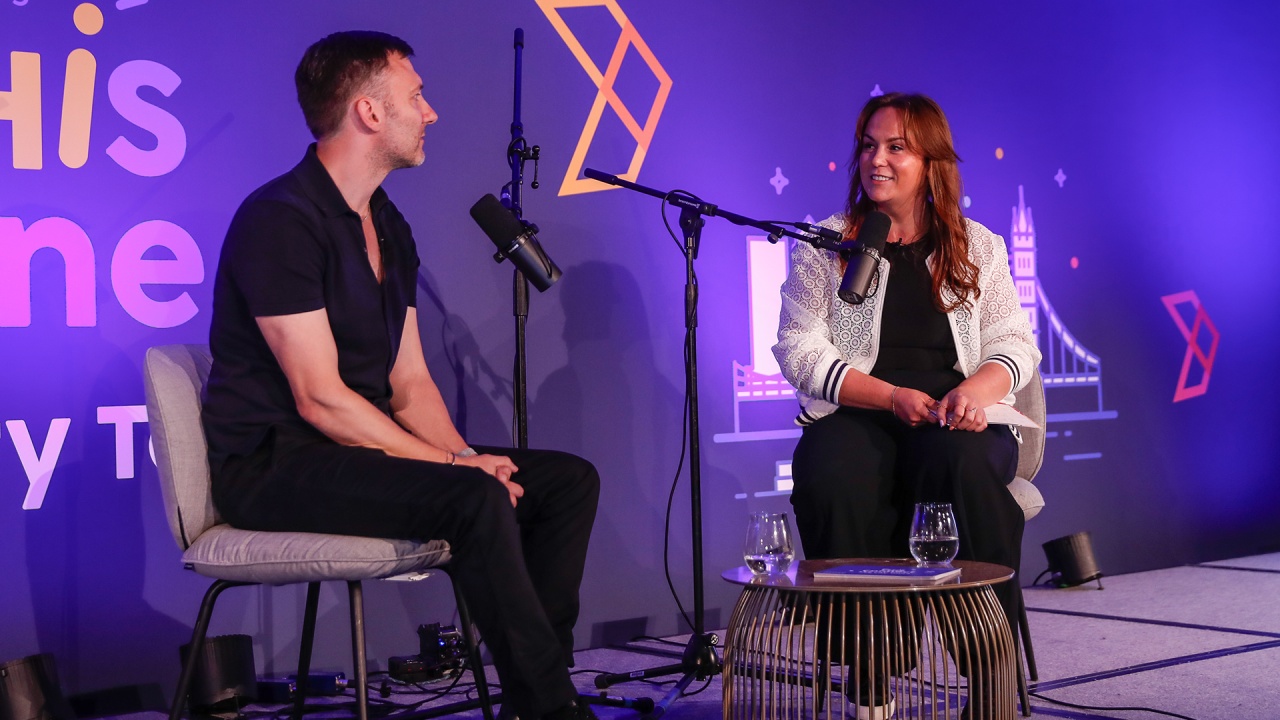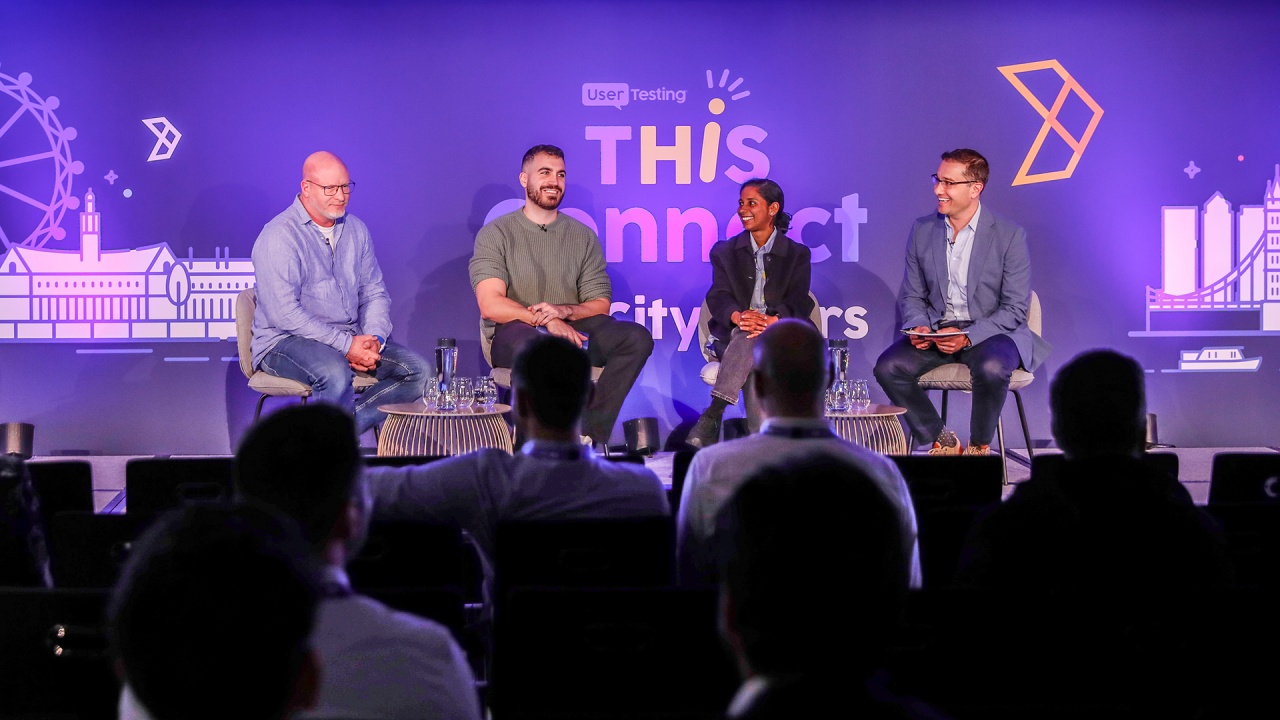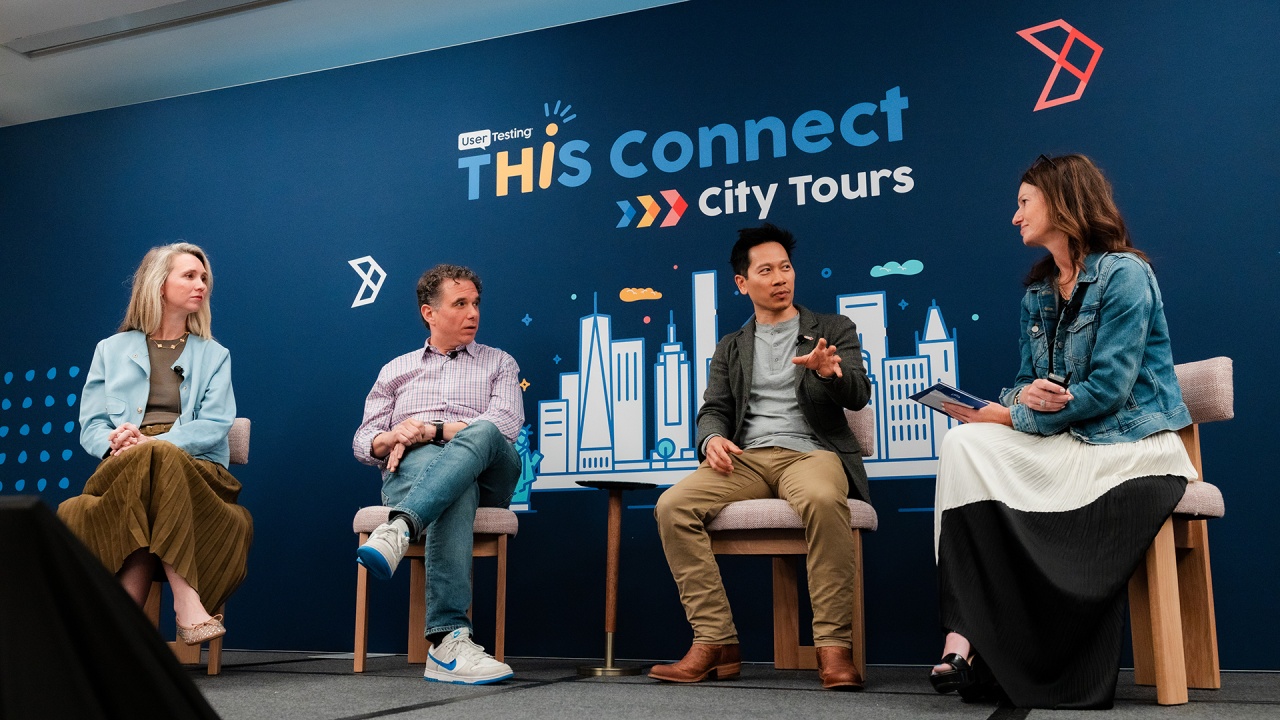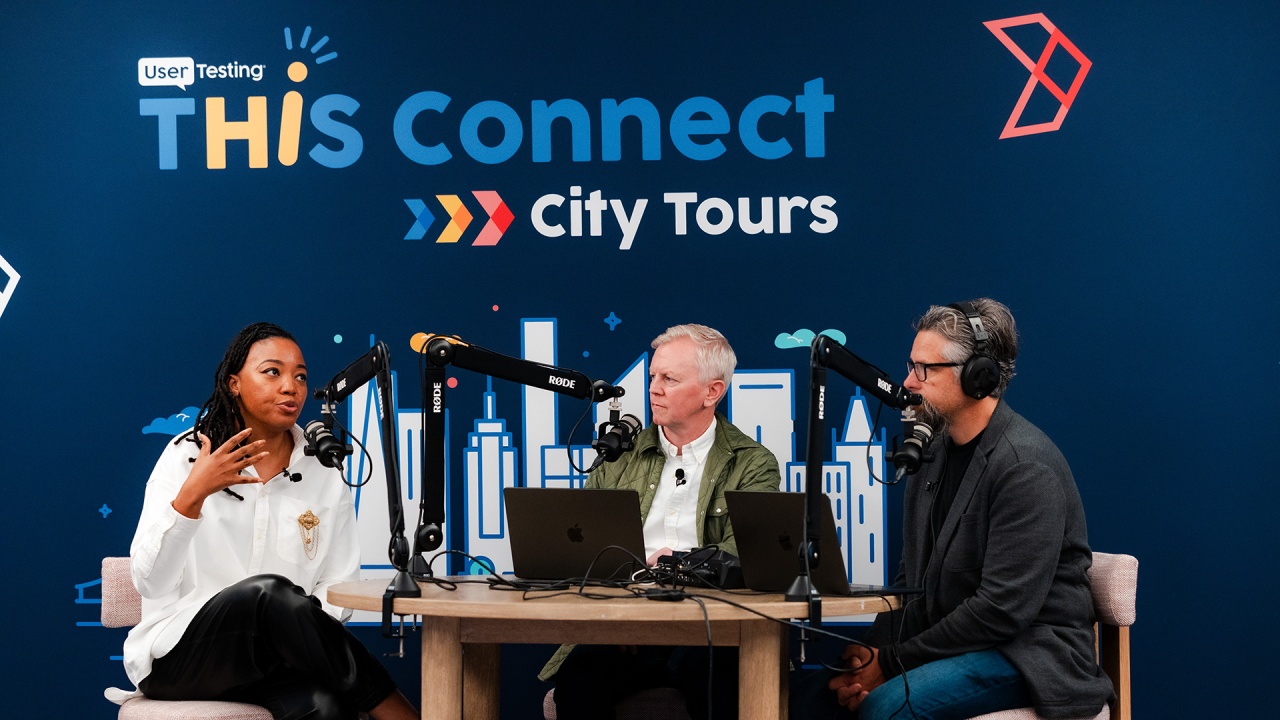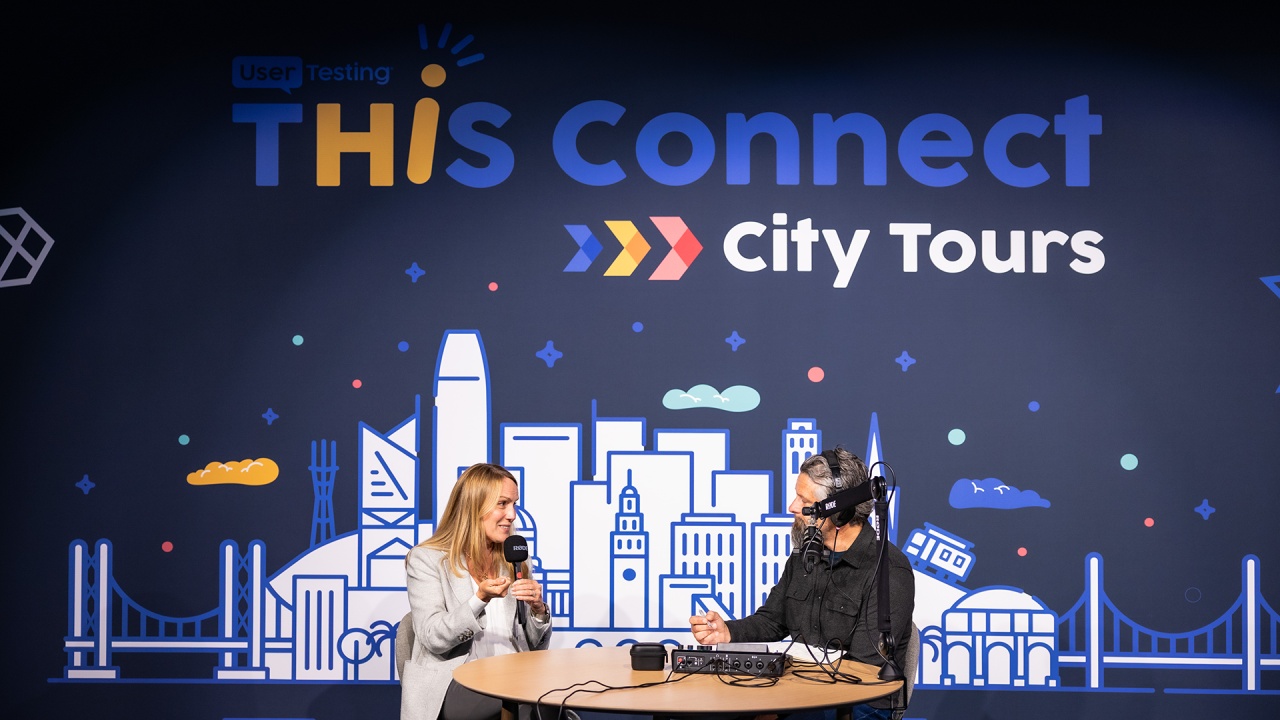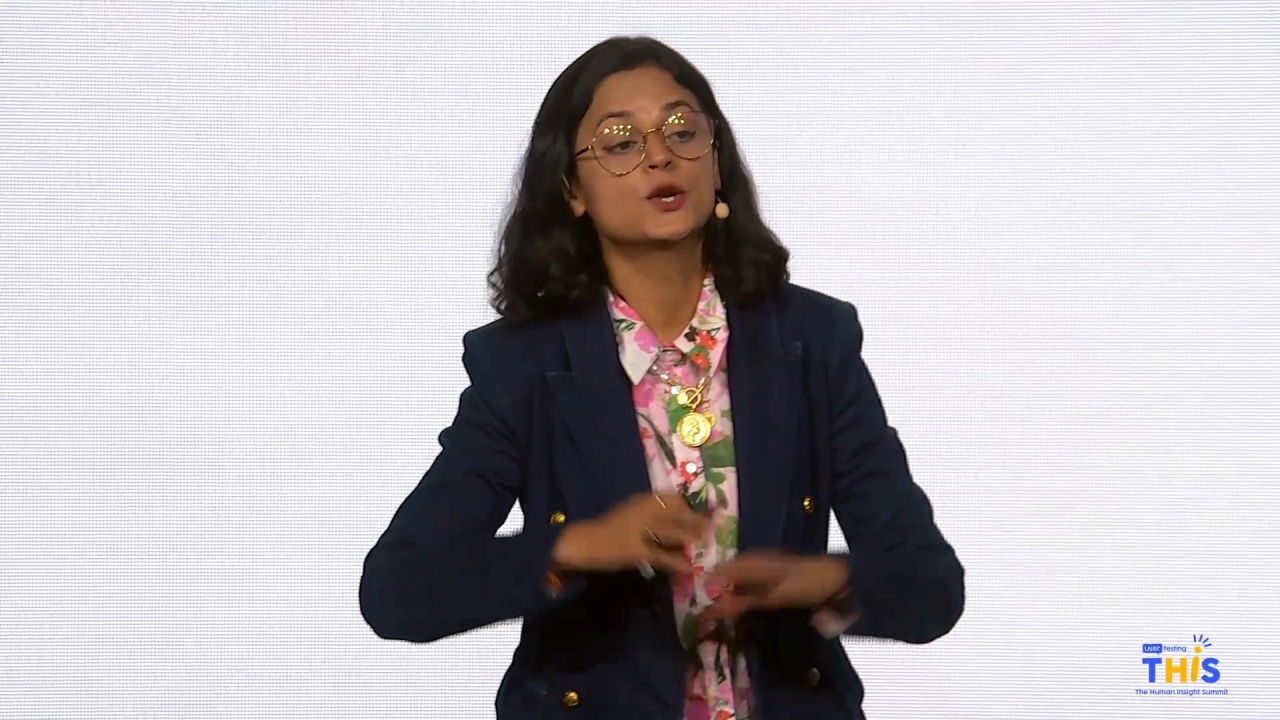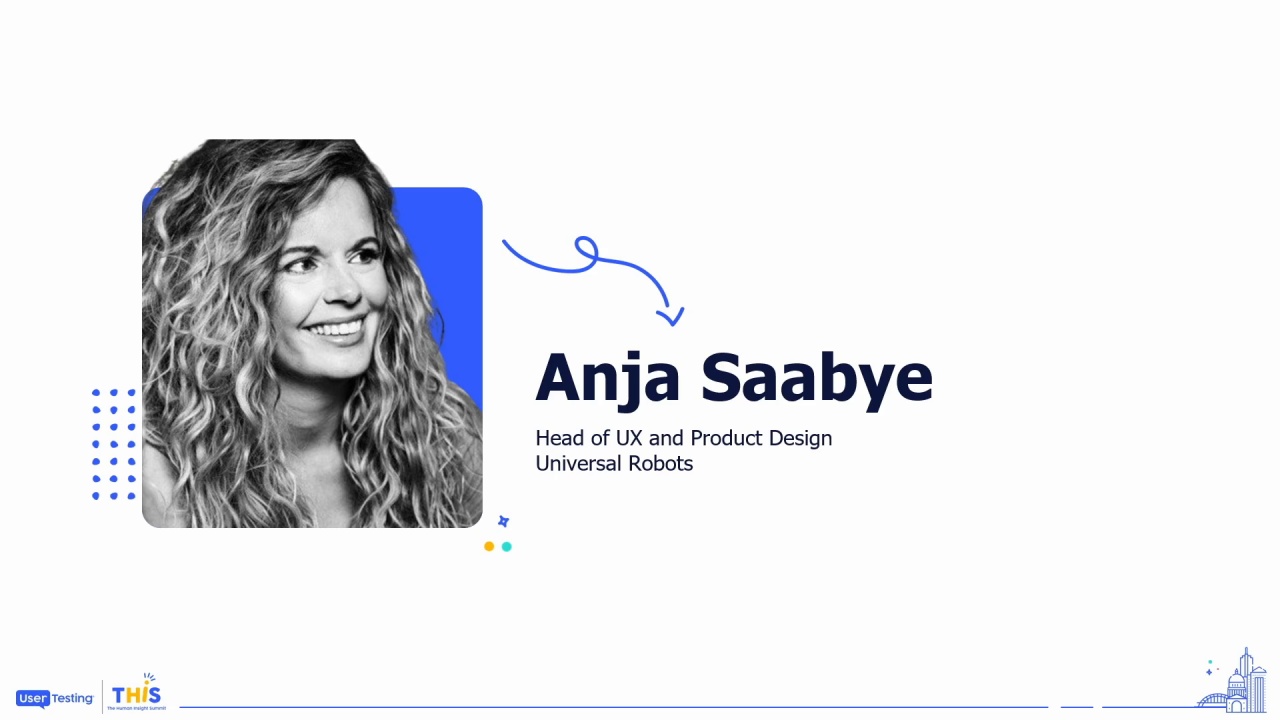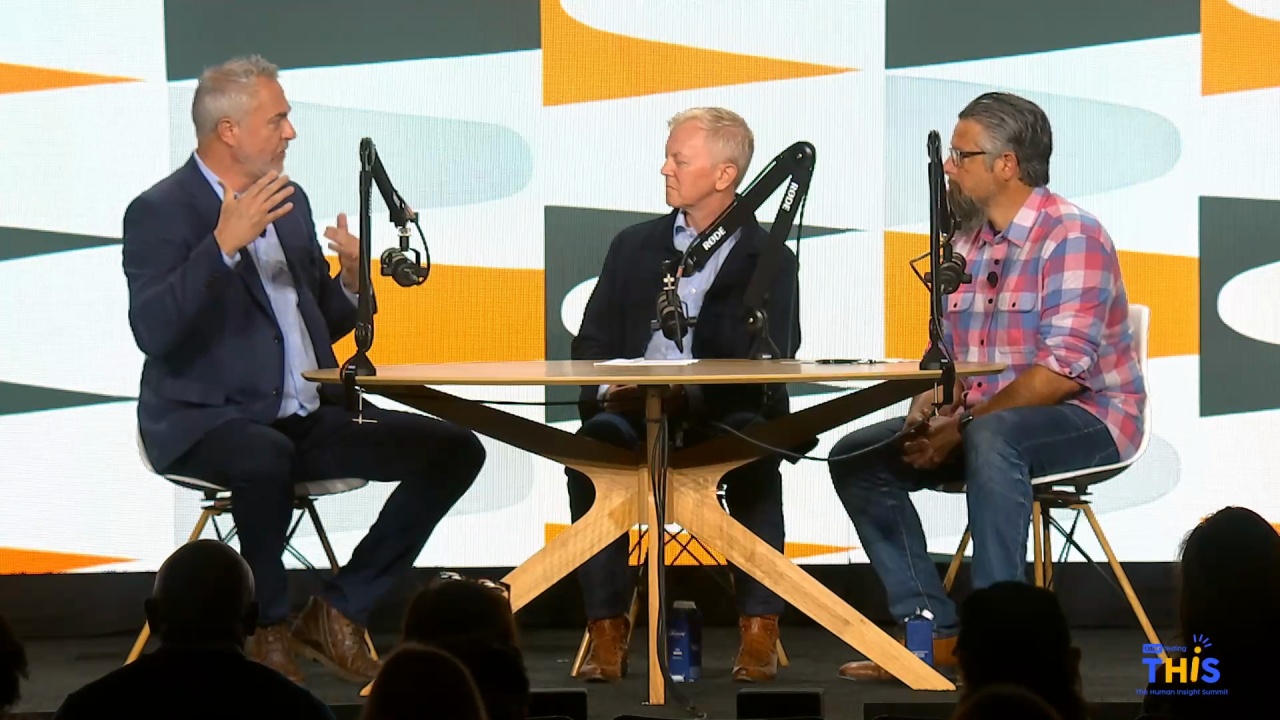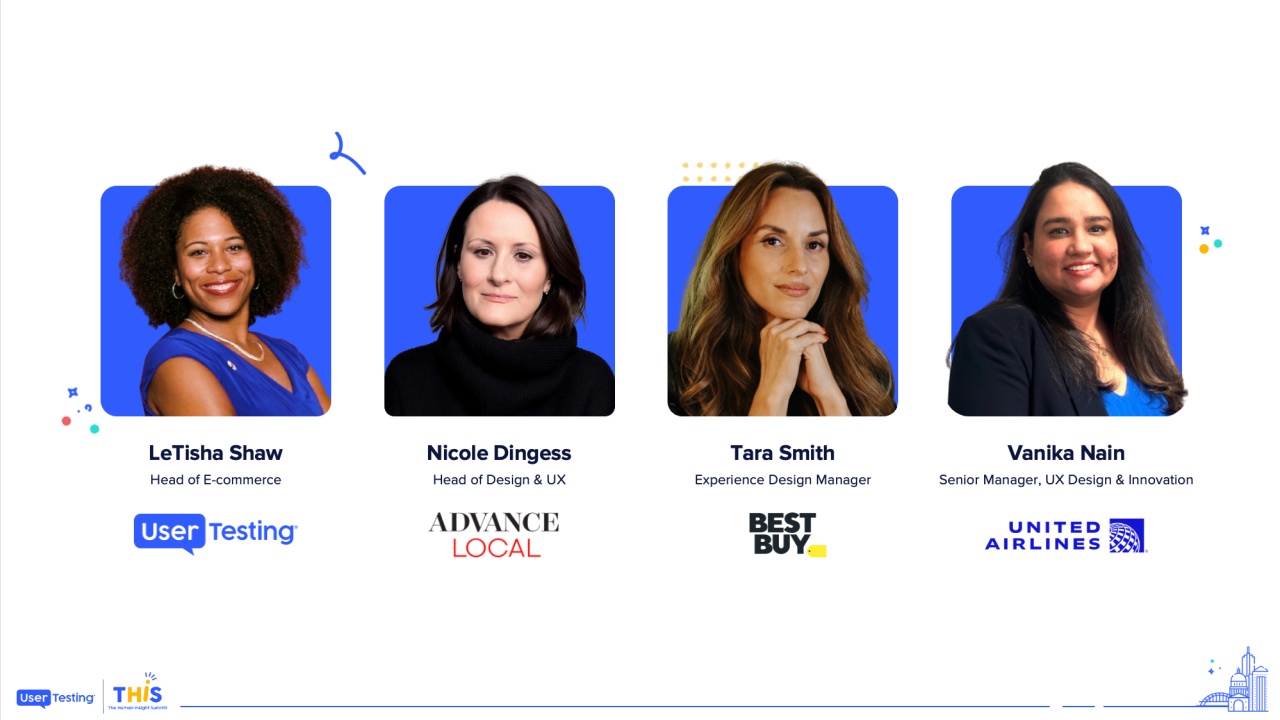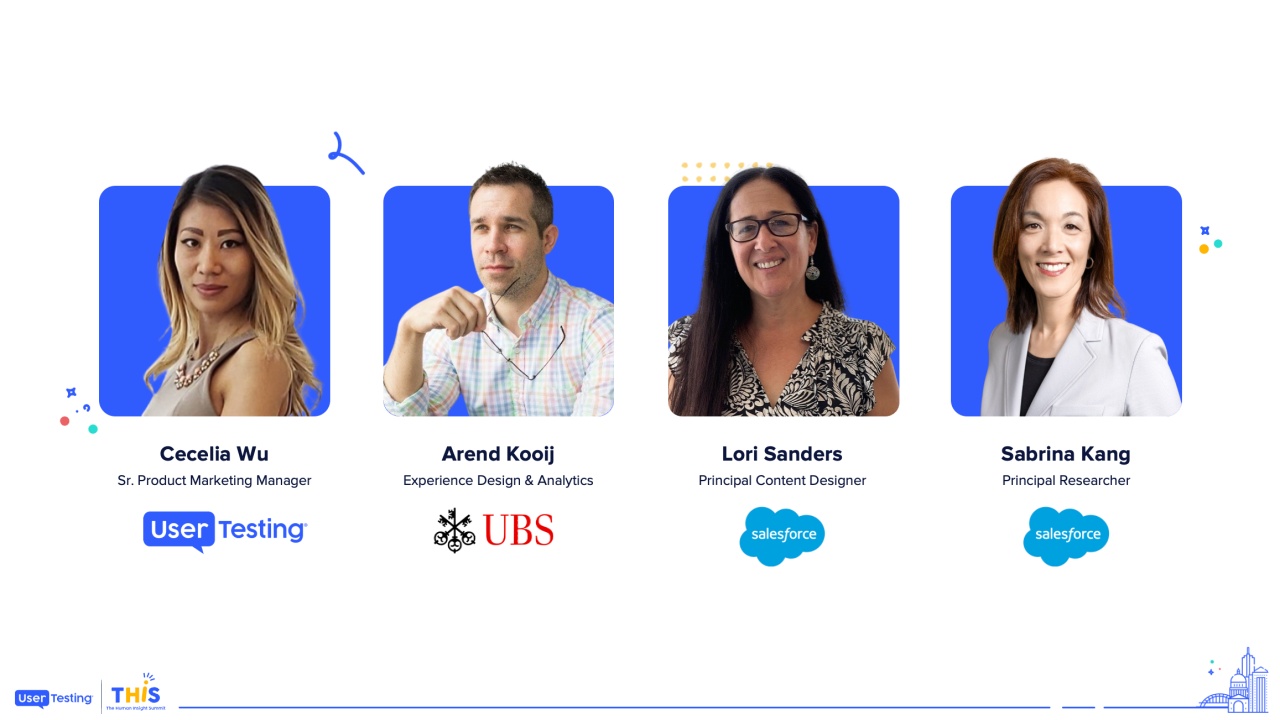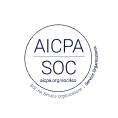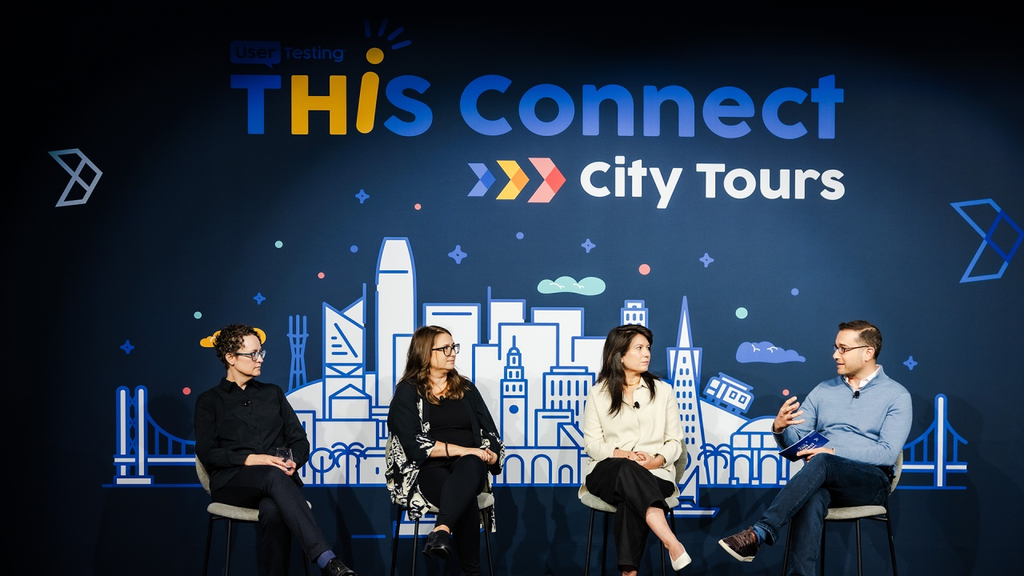
Panel Discussion: Delivering on Brand Promises Through Human Insight and Design
Samantha Warren
Senior Director Design, Adobe
Leanne Waldal
Customer Experience, Research Leader
Baran Erkel
Chief Strategy Officer, UserTesting
Raeling Kirk
Senior Director, Customer Insights, Collectors
As organizations scale, staying connected to the customer—and consistently delivering on brand promises—becomes increasingly complex. In this panel discussion, leaders from Adobe, Collectors, and a seasoned CX research leader from a global technology company will share how they’re driving smarter decision-making, fueling innovation, and ensuring every product, service, and experience stays true to the brand. Join this conversation to learn how top enterprises are operationalizing customer centricity through insight-led design and collaboration.
Kicking off this afternoon with a panel conversation focused on a challenge that many of us are navigating, which is how to consistently deliver on brand promises as organizations scale. So this session will explore how leading teams are using human insight and design to stay aligned with customer expectations, make smarter decisions, and build experiences that reflect the heart of the brand. So to lead this conversation, it gives me enormous pleasure to welcome Esteej, my pal.
Welcome, Baran Erco, chief strategy officer at User Testing, along with a fantastic panelist.
I'll let you come come on. Come here...
Kicking off this afternoon with a panel conversation focused on a challenge that many of us are navigating, which is how to consistently deliver on brand promises as organizations scale. So this session will explore how leading teams are using human insight and design to stay aligned with customer expectations, make smarter decisions, and build experiences that reflect the heart of the brand. So to lead this conversation, it gives me enormous pleasure to welcome Esteej, my pal.
Welcome, Baran Erco, chief strategy officer at User Testing, along with a fantastic panelist.
I'll let you come come on. Come here.
Cheers, buddy.
Thank you. Thank you very much, Jamie. Alright. Hello, everyone.
I hope you had a great lunch. What an an amazing morning. We had Joe and Jamie on the couch. We had Nakia with paper, analog presentation.
We had Ray with PowerPoint on AI in the future and kind of blew my mind, with the ten x thousand x. So I am Baron Erkel. I'm the chief strategy officer of user testing. I'm thrilled to be here for what's gonna be an insightful conversation. We've got, a really interesting discussion to talk about how we scale insights in organizations, how we democratize research and insights, how we use influence to drive impact, and how we use insights to make smarter decisions and ultimately build experiences and brands that customers love and keep coming back to.
So with that, I'm joined by an incredible group of panelists here, I've gotten to know these three, ladies over the last month, and I think we're gonna have a fantastic conversation, so I wanna welcome them to the stage. First, Rayling Kirk, Senior Director of Customer Insights at Collectors.
Give it up.
Hi, Rayling.
Samantha Warren, Senior Director of Design at Adobe.
Say hello to Samantha.
And Leanne Waldahl, a seasoned Customer Experience Research Leader. Come on up Samantha, I mean Leanne.
Welcome.
Thank you.
Thank you so much for being here with us. Let's dive in. So first, just to kick things off, I'd like each of you starting with you, Railing, just to introduce yourselves, a bit about your organization, what you do, and how insights, has played a role in your your journey.
Absolutely. So hi, everyone. My name is Raelynn Kirk, and I lead consumer insights at an organization called Collectors.
It's the largest authenticator and greeting company for collectible cards and memorabilia. So sports cards, Pokemon cards, sports memorabilia.
I joined two years ago to build out the consumer insights function.
Before me, it didn't exist. So I'm excited to talk about kind of how we've grown, how we've built trust with our stakeholders, and ultimately, how we use research to fuel, decision making at the organization.
Before collectors, I was at a buy now pay later company called Affirm.
I was their first research hire pre IPO and post IPO to build out our market understanding of who the customer is and ultimately what markets we need to enter using data and research.
And then before that, I was at Sephora leading consumer insights, across the organization for loyalty product innovation marketing.
So yeah.
Fantastic. Thank you. Samantha?
Hi. I'm Samantha Warren, and I am the senior director of design for Adobe Firefly.
If you're familiar with Adobe, we are, we create, tools for creativity. And so FireFly is our new product that focuses on the future of generative AI, and my team works cross media type, cross customer type.
And my team is very much embedded with the customer. We're kind of a little bit of a meta team in many ways.
As designers, we are creators creating for tools for other creators. And so there's a lot of really interesting things that come into that when it comes to gathering data, talking to other customers, and doing research. And so I'm really excited to talk with you all today.
Excellent. Thanks, Amanda. Leanne? I'm Leanne. I run customer, experience research and strategy. And in the past, I have led research teams at a lot of different companies, ran my own agency.
I'm really excited to see AI coming back because my first job out of college, which was about two hundred years ago, was using neural networks to make predictive models for marketing teams. So it's really fun to see it come back, and right now I run a project on consumer perception of AI.
Fantastic. Thank you. Thank you. And, you know, I used to collect baseball cards as a kid, and now my son collects Pokemon.
His room is filled with Pokemon cards, so, I feel a connection. And I've used Firefly. Now I try to use all the tools. I use Firefly for some of my presentations.
Actually, our user testing, kind of we have a vision vision twenty thirty, exercise that that's never ending.
We can talk to you.
And I I use Firefly for our futuristic, images there. So Nice. Awesome.
I wanna do it just a quick lightning round, and then we'll get into some more topics. But just one thing about your role that that people, might be surprised by, or might not expect?
Well, one thing I was talking with Raelene and Samantha about this, that people don't usually realize that when you do research and strategy for b two b, you're doing a lot of things that are really similar to sales and customer success. And it surprises people when I say people who are really good at research and strategy for b to b SaaS are often also really good at customer success and sales because we are working with those teams constantly to get access to customers, to get access to end users, to understand what they're doing, and then to file the service tickets and the Jira tickets for all of the things that we find and bring insights back to the product and design teams to help them with innovation and strategy.
I think for mine, it would be, that being that my team specifically works kind of on the innovation arm of our products, it is a lot more art than science, I think. I think we use a lot of frameworks from traditional product design, but when it comes to understanding and being able to predict the future, it's nearly impossible. And so it has to be a combination of both gut from the experience that we build up, whether it be ourselves using prod our products or talking to other people in the community with our products, and also going out and doing a lot of user research. So it's a bit of bit of both.
I think for me, what I've learned at collectors is research can be really can be used as a secret weapon. I think, like, earlier in my career, I found that people would view research as, you know, it takes too long or it's gonna get in my way or, it it doesn't drive enough impact. But what I've seen at collectors is, you know, all the research that we've done around our customers' segmentation, personas, new product development, it's helped to level the playing field for our product managers, our designers, our marketers because everybody is on the same page around who the customer is, what do they need, and ultimately, what do we build.
And I think that it's actually created a lot more efficiency, especially at the executive level, because everyone is aligned on what are the key priorities for how we drive growth, and that is all rooted in customer insights.
Fantastic. Thank you. So superpower, gut plus data and research, and and actually thinking about sales, and its relation with research. Very, very good.
Let's dive into some topics. We've got a few themes here. So the first one will be managing insights and research. And, Rayling, I'll start with you.
You talked about how you've kind of created organizations. You've kind of gone zero to one, the collectors and previously. So you've got an a centralized insights engine really fueling the strategy, helping fuel strategy across collectors. So I guess thinking about an a centralized model, what are some of the the advantage, advantages of those and and, you know, how has it played out?
Absolutely. So, at collectors, our research team is made up of UX and market research and analytics. So typically in the organizations that I've worked at previously, market research would sit under marketing. UX research sits under product and design.
But what's worked really well by having a central organization where UX researchers are actually working with market researchers, they're able to kind of cross pollinate all the insights that they're learning on their respective projects, and it's ultimately created a cohesive voice of the customer. I think one of the the pain points that I experienced earlier in my career was, you know, UX researchers doing research for product and design, marketing researchers over here, you know, doing customer segmentation and personas, but they weren't really talking to one another. And so there was sometimes confusion across the org around what does a customer want at the end of the day, what should we prioritize. And I found that, you know, having a centralized organization where there's, again, just one cohesive voice of the customer has really provided a lot of efficiencies for the organization.
Fantastic. The elusive single view, single voice of the customer that we all strive for.
Leanne, you you've seen lots of models in your career. You've worked with both centralized and decentralized, research orgs. You know, what have you learned about what it takes to scale insights effectively in in either model and and, like, what's overlooked?
Well, it's definitely not a one size fits all. Like Raylene, I was at, Dropbox when they were quite young and grew their first research team, and so it needed to be market research, we needed to understand buyers' journeys, we needed to do pricing and packaging research for the new business product. We needed to be you doing end user research for product and design and engineering and strategy. And then I've worked at agencies where we have a leadership team of me and a few other people who are running research projects across, and in each of our offices, we have researchers.
But those some of those researchers, you know, out in New York could be working for me in San Francisco on a project that I'm running, and, you know, people who are other places could be or on my team could be working for someone in the Kansas City office or something like that. I've also when I've structured research teams at companies had both decentralized and centralized, so embedded researchers on specific teams to make sure that that team had someone who could be constantly feeding them with insights and helping them out. But also particularly at larger companies, when there's not usually people looking holistically across the customer's whole experience, keeping some people out of being embedded so that they can be looking at entire workflows across products or, you know, products that work together and also be working with marketing to say, like, let's bring in commercial insights and marketing insights to inform what we're learning about the market along with our current customers so we can get a whole picture to feed into the road map.
Fantastic. Thank you. So that there's no one size fits all. Different models can work in different contexts and organizations.
What matters is the customer, the customer experience, and the customer shouldn't be able to tell your org design based on their experience with your company. Right? That's the things I've heard.
Samantha, let's talk about empowering designers and what you do. You sit really on the innovation side, like you said, in enabling, you know, designers to embrace continuous learning.
Yeah. What does that look like in practice, and and how do you strike the balance between open exploratory research work, and also just driving business results?
Yeah.
Well, research and customer relationships are really a partnership. And so at Adobe, we have a centralized research team.
They are very closely embedded with the designers. But the expectation amongst the designers on our team isn't that, like, oh, hey. We're gonna go off here and design this thing, and, oh, hey. You go off and talk to the customers.
It is a collaboration, and everyone is continuously empowered to be able to do whatever it takes to have a level of confidence they need to be able to express a point of view. And so I'm from my standpoint, I am not very prescriptive here. I believe that everybody should kinda do whatever it takes in order to have a level of confidence. But like for example, if I have a designer that comes to me and they're like, hey, I have this design, but I don't I don't know if users will really, you know, like this or or use it.
I don't know if it'll be effective in reaching our business goals. I will say, well, what do you need to do in order to get confidence? You know? And so it may be that they need to go out and talk to customers, and maybe that they need to actually build a prototype and use it themselves and do, like, a do an audit or a walk through.
It could be partnering with one of our researchers to conduct a larger study. And all sorts of different factors obviously come into play, you know, what is the timeline, what sort of resources do we have access to, do we have access to something like user testing to be able to conduct some quick and dirty like insights.
All of these things, come into play, but it is the fact that I expect all designers to have as strong a point of view as they would if they themselves were going to use the product themselves. And that takes talking directly to customers and getting, insights and a lot of times data as well.
Awesome. Thank you. I we talk about having a strong point of view a lot at user testing too, and the product team, You know, you know, you've got to balance insights with ultimately making decisions, you know, that are gonna impact customers and have a point of view that then you continue to refine.
Leanne, I wanna switch gears a bit and talk about influence and impact across organizations. And so, from your lens and research, how do you help ensure that the promises made by product, shared in roadmaps and all that, you know, actually are delivered through the customer experience, and and, you know, how do you work together and kind of make sure that connection happens?
Yeah. I think persistence is the biggest thing.
A lot of people think, well, I did all this research and, you know, I put together a PowerPoint, and I shared it out a few times in a meeting.
Why isn't anybody paying attention to me? Well, half of research is sales and marketing of your work, and you have to be continuing to sit in the meetings, invite yourself to meetings, be in meetings, meet with people. When you see stuff happening, remind them, like, oh, remember we learned this about this population of customers or about this segment of the market? And go back to people and say, you know, how did what I do as a researcher, have impact on your design, or could you let me know what's happening in the product based on what I did? Be more collaborative across the org and, like, use those social skills skills that you have a researcher to talk to people to use it to talk to the people inside the company to get to know where you're having influence and impact.
And a lot of times, the big complaint about research is it takes too long.
So what I tell people is find out what too long means. Too long means different things for different people.
In one case, too long just meant, like, I don't want it to take more than two weeks. And so I said, well, how can we get, like, all of their research operations going, because that's the stuff that takes a while, to make sure that from start to finish of any research project is doesn't take more than two weeks. So just working with people to figure out what works for them and what their definition of things are and when they need things by, and then really, really working collaboratively across the whole org.
Fantastic, thank you. Samantha, you mentioned that, you know, learnings come from across your design organization and help inform the innovation roadmap.
You know, how do you ensure that customer insights shapes not just the solutions, but the decisions around which problems to even explore and tackle in the first place?
Yeah.
I mean, a lot of it a lot of it really kind of comes down to storytelling, and the ability to be able to weave together the insights and the actual, vision that you are trying to push forward and to try and get traction on.
Again, it comes down to this collaboration. Right? It's not gonna just be any one designer who is putting together and trying to, push a particular business point of view or customer point of view. It's going to be a collection of a lot of different things that come together, and telling that story is, like, the key the key vehicle in order to making an impact and to driving results.
So I really work a lot with our team on making sure that they understand that what what it means by storytelling. How do we actually bring the customer story into the the idea that we're pitching or the user experience that we're designing?
I very rarely will look at any design that doesn't have a very clear reference to an actual human customer before we get into the actual design. Because if we're not solving a user's problem, the entire point is lost in the pitch or the idea or the user experience that we're trying to get ahead of. And so, obviously, the business results are kind of the end goal, but how we get there and the story that you tell is such a key component to all of this.
And I find that the collaboration between research, designers, and actually customers, I kind of when I think about the process and how we do design work, I think of our customers as part of that process. I make the assumption that they were just as involved in giving us the information we need in order to tell that story as, you know, the prototyper or the user experience designer who's involved. I see them as a key component of, of the entire process.
Fantastic. Yeah. This morning, Jamie talked about co innovation as one of our, you know, values, here in B2B you can sit down and have design partners and then B2C you need to bring that feedback in and as if they're innovating with you based on that feedback. So, Rayling, when we first spoke about a month ago, you described your approach to getting insights to travel across organizations as relentless, communicative, and empathetic.
So can you share how each of those qualities has shown up in your work and, you know, how it's helped you build the influence to be successful?
Yeah. Absolutely. So, kind of going back to what Samantha said around the storytelling, a lot of that is number one, bringing our stakeholders along the research journey. So whenever we're conducting primary research, whether that's, you know, interviews through user testing or focus groups, we invite all of our stakeholders design product marketing when the research is wrapped, we also try to connect the dots with maybe some survey research that we have done on a relevant topic or we bring in, behavioral insights from our analytics team to kind of paint the full picture.
Because I think a lot of times what we hear from product folks is, okay, well, you only talked to six customers. What is this you know, can we have confidence in this? And it goes back to having this centralized research team that actually has really a holistic view of the customer end to end from how they are behaving on our platforms, to what they're telling us, to what we're hearing from the market.
So that's number one.
I think taking a playbook out of kind of the marketing brand funnel, which is awareness, intent, conversion.
A lot of the research that we do is we have, you know, share sessions where we share with our stakeholders the research, but then we also publish a quarterly newsletter. So it's just that constant reinforcement and always talking about the research that you're doing now, how it's connected to the other research that you're doing that you've been doing, how it answers the questions that they have today. But then thinking ahead to the future and trying to get ahead of what product is trying to build and making sure that the road map is both, yes, answering the immediate questions you have today, but then thinking ahead to the future, how can I be doing research now to anticipate products questions or marketing's questions so that they feel like you're really kind of, hand in hand with him with them on the journey and really trying to tackle the business problems, both in the present, but then looking ahead to the future?
Fantastic. Relentless.
I love it.
Let's shift gears a little bit to talking about driving innovation, and we'll start, Samantha, with you because that's where you sit every day, but we'll, go around to everyone. So hard question maybe, but, you know, how does customer understanding, help drive new ideas and actually innovate? I mean, innovation is hard. It's not easy.
Yeah. And that kinda goes back to the art versus science piece of it.
You know, I what is the old saying that if, Henry Ford had asked people what they wanted, they would have said a faster horse, and that's kind of the case with Gen AI. And I go back to the first time I actually saw, Gen AI in action. I was admittedly a skeptic myself. I was like, why would I use this thing? I kinda want this. I don't see what problem it's gonna solve. It's it seemed to me very much like a a bit kitschy and a little bit of, you know, a little bit more of a party trick.
But as I actually started to use it myself, that's where all of the experience that I had talking to customers or using our products started to come into play to kind of be that magic, that alchemy that needs to happen. It was all building there. While I could not necessarily see the direct application right there in that moment, I could feel that there was something here. Right?
I was like, oh, wait a minute. If you can put in some words into this weird chat box and get this image back, what else could you do? Like what other things could you put into this box and get back. Right?
And so I I think when it comes to innovation, again a little bit more art than science, but it is about the long term impacts of the repository of insights that you gain over a period of time. And really, really collecting those and embodying those and then being very, very much in sync with your customer and your user. I think the more people understand their users, the more that they can start to envision and take the leap that they might not be able to take in some sort of, you know, user test, for example. Because somebody in a user test, they might not be able to see that where things are going, but you yourself can feel where it's going.
And so, my answer to the question really is about kind of this alchemy that happens and being able to paint those pictures. We still use customer insights quite a bit. My team will go to, go to the screen, design ideas based on that intuition and that alchemy, and then take them out and show them to people, ask them if they would solve problems. And sometimes we get answers back that might not be the answers we expect, but snowball into the next set of ideas around innovation that we could bring to the table.
And so it's a constant process that's building over and over, and oftentimes leads in directions we don't expect.
But having that kind of, experience is really, really key to the process. Mhmm.
And just a quick follow-up. How how important is speed of feedback to kind of inserting it into the process? Because you're, you know, you're moving at a at a pace.
Yeah. I think about a study we did, a couple months ago that's already fairly out of date. I mean, especially in the world of AI, the technology is changing so fast. Speed is critical.
Like, we have to be operating very quickly. We have to have customer relationships that we can quickly lean on in order to get fast feedback. And that's oftentimes even why we have to rely on gut sometimes because there's just not enough time. We have to come up with an idea.
But the speed the speed of it is is on a a new level for sure right now.
Fantastic.
You talked about systems a little bit or you used the word repository, made me think of systems.
Leanne, question for you. So how can organizations build systems where the research naturally fuels innovation, you know, especially in environments where experimentation and speed are critical? I know you're a kind of system.
Yeah, so there's lots of Customer Insights Hubs tools out there right now. User Testing has one called EnjoyHQ, and there's a lot of others. A lot of these tools give you the ability to bring in all the data from your research team, but also bring in all the data from service tickets and success calls and sales calls and Salesforce and and data analytics. And then everybody in the company can now use AI to chat with that data, or search across that data.
And all of a sudden, it opens up the ability to see everything in one place that's about the same topic. So before, you might have to go into Gong to find out what was going on on sales calls. You'd have to go into intercom to hear, what's going on on service tickets. And you'd have to go into, you know, SharePoint or someplace to find all the things that the research team is sharing.
And now all those things can be in one place, and everybody can have an experience of searching through it. That's something that I've seen happen just in the last couple of years that hasn't existed before. We haven't had the tooling. We haven't had good natural language search.
We haven't had AI chat. And now I think that's there for companies to start thinking about how to start creating these systems and putting everything in one place to be able to enable things like that.
And and a follow-up there on in addition to this tooling and the systems, you know, what's the the kind of culture change, you know, side of things? How do you how do you actually get that to work in an organization, to be effective in terms of driving innovation?
Well, the current experience of a lot of people in product and design are I have to, go to research and ask them for help. Well, if you have a system like this, you can just go in and ask your questions and see if you can find the answer, and then you can rely on the research team to help you figure out, like, what's going on there. So you don't necessarily have to do lots of net new research, particularly if you're in a really large org and it's really hard to know what's going on in all the different corners. You can use systems like this to to enable yourself as a product manager or designer, or even a researcher when someone comes to you and says, you know, I'd like to know something about, you know, do people like blue pens or red pens?
You can just go back into your system of record of all the different data you have about blue pens and red pens, query it, and go back and say, well, we already know that. We did a study about it two years ago. Couldn't have found that if it was on SharePoint. Wouldn't have known this if I didn't have all these Gong calls to search through.
But I can get all this data and I can be a much, you know, sort of, like, quicker, more efficient researcher by doing that. So as a researcher as a researcher, I can just focus on the things that researchers love to do, which is, like, discovery and uncover new things to, you know, come up with innovative decisions.
Awesome. Thank you. Okay. Ray Ling, innovation. So when you think about, you know, fueling, innovation with insights, how do you balance you know, you've got the centralized work. How do you balance really working on foundational understanding and discovery with the need to move quickly and test rapidly and and get things out?
Yeah. I think, I think I've learned that you actually have to always prioritize the foundational insights first because that will yield dividends to helping to answer the immediate questions that the business has eventually. And so, at collectors, I was I joined and as you can imagine when you're the first research hire, there are so many questions that are being thrown at you, but I knew we had to start with consumer segmentation and personas. We had to align the organization around who is our customer.
We had to bring everybody along the journey, product, marketing, analytics, sales, the business to make sure that we had a cohesive understanding of who the customer is and then what are the problems that we're trying to solve. Because I think if you just kind of jump in and answer kind of a lot of the tactical things, you lose sight of kind of the bigger picture.
And what we've we've found now is the whole organization references the consumer segmentation research and it's really aligned our teams, to actually becoming better collaborators.
And it's really provided a lot of, harmony across the organization for who is the customer, what do they need, what is our market opportunity, and everyone's kind of marching in that one direction. And so I think without doing that first step, you run the risk of just creating a lot more, churn for yourself down the road.
So that's kinda how I I, approach those those two different things.
Gotcha. I've I've heard the term go slow to go fast.
Exactly.
Yeah.
Awesome. Thank you. So our final topic, and then we'll see, may have time for some q and a, but we we're in San Francisco in, twenty twenty five. We have to talk about AI a bit more.
So we'll just go, round robin here. So looking ahead, I think we're all doing this every day, trying to look around the corner. What are your top two predictions for how AI will impact your field in the next few years? And we'll start Oh, sure. With you, Leanne.
I think it's I think it's becoming a great assistant.
I think we see that when you go into Gmail and use Gemini to help you write an email to someone. My wife and I, use Gemini and Gmail to send jokes back and forth to each other. You you have to ask Gemini to write a joke, and then you cannot say no to it. You have to send it.
It just adds a little whimsy to, like, what otherwise is just, like, you know, planning dinners and things like that. I see a lot of hesitance among researchers to adopt AI as an assistant, and that's fine. We were really slow to adopt e commerce and put our credit cards into a website, twenty five years ago.
But I do think it's getting there to be sort of like an assistant for my human intuition and an assistant for the things that we humans know how to do really well.
I think my wife would love it if if instead of dad jokes, I just had Gemini jokes in the house. Samantha.
So for me, it's around skill expansion, and I am going to really hone in on specifically design and creativity here. I imagine a future that is incredibly multimedia.
People who previously might have only been two dimensional designers may also expand their skill set into three dimensions or animation, and I think you could probably take that in a lot of different ways. You might see designers who do more research sometimes, researchers who might also do design sometimes, because I think the barrier to entry to learning new skills is going to drastically drop. And that doesn't necessarily mean it will replace bringing in people with those specializations.
Like for example, once, video came out for AI, I put together a pretty quick little story about my dog. Not something I would, like, show necessarily, like, as part of my professional career, but it helped tell a story. It actually helped tell a story for a presentation I was giving on a different topic. And so I think that storytelling, again, will be, kind of a through line throughout, the future of innovation.
And how you tell that story will get more and more interesting as people have the ability to, expand their skill set into other media types.
Fantastic. And I I asked for two predictions.
Oh. Get get another one from you, and then Leanne, did we get two from you?
I think you did.
I think I did.
Because I can't think of any more.
And it doesn't have to be design kind of research related to me like, hey, you know, robots are gonna take over.
Well, I think there will be more of a focus on craft generally. I mean, I think, I mean, I do a lot of I talk a lot with technologists who are like really stoked on like, oh, this is gonna replace all the things. And I'm like, woah. Woah.
Woah. But, like, if you look at the history of technology and how, it impacts society, there's always a bit of a backlash. Right? And so there are going to be major advancements in how, AI is going to impact all of our jobs.
But I think the focus on those who have high degree of craftsmanship in their jobs will be more and more valued and sought after.
And so for me, I'm really excited about that. I can't wait to see the specialist to, like, really dig into an area that AI just cannot necessarily replace. I think that'll probably spur a really cool new artistic movement.
Well said. I I hope so. I hope you're right. Ray Ling, two predictions.
Two predictions. Okay. I think number one, it I think it'll democratize a lot of, kind of the organization's access to research and data and insights. We're already experiencing this now because we onboarded a platform called Glean.
So all of the research reports and everything that we have on our customers is uploaded to this platform. And if anyone, you know, joining the company needs to learn anything about our customers, it's right there. So I think that's one. I think to be honest, I think we're still trying to understand and learn how to use it.
So we've been experimenting and kind of pressure testing, a lot of kind of the the LLM models by putting in the data that we have on previous research persona segmentations as one example, giving it everything that we did through surveys and and focus groups and asking it to tell us what are the the main segments and the personas and what's the market opportunity.
And it's still spitting out really weird things that we know would just not actually land, with with the organization. And so I think I think we're still learning how to use it and when to use it and how to kinda treat it more of like an assistant to do some of, like, the kind of more, maybe operational tasks that would typically take a lot of time, but now you can just say, hey. Write me a discussion guide or write me this survey, but it's not perfect.
And I think the I think to your point too, like, I also hear this narrative, like, oh, it's gonna replace all of our jobs. And I think what it's missing is it it, a, doesn't understand context, and b, it doesn't understand what your organization needs. So it doesn't really give great recommendations, and it doesn't it it's not kind of this magic wand that you can wave and and you input all this data and it gives you all the answers because it's lacking that context and kind of the human connection, and the overall kind of understanding of like a business and and where it needs to go. So I think we're we're still learning.
Oh, yeah. Yeah. Learning every day. That's fantastic. Thank you. So we're it's gonna make us more efficient.
It's gonna augment our our lives and our work, but the human, the craft, is still gonna be at the center. I think is is are some of the themes I heard. Please help me thank our wonderful panelists here.
Thank you all very much.
